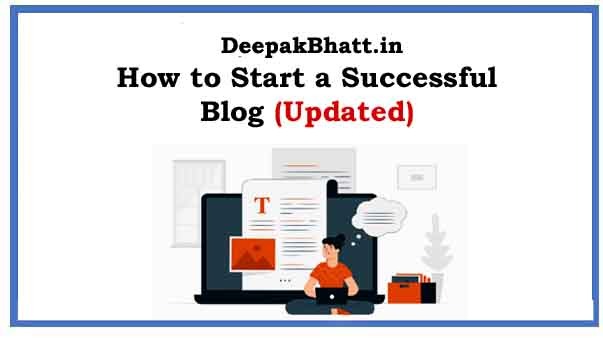how to start a successful blog A blog is a type of website or online platform where an individual or group of individuals regularly
Share their thoughts, opinions, experiences, or information on a particular topic or niche.
The term “blog” is short for “weblog” and was initially used to describe online journals or personal diaries that individuals would update with their thoughts and experiences.
Microsoft Power BI: A Comprehensive Guide
Software Testing Bootcamp Complete Course
How to Start a Successful Blog
Blogs have evolved, and today they can cover a wide range of topics, including news, politics, entertainment, lifestyle, business, and more. Many blogs allow readers to leave comments and discuss with the author and other readers.
Blogs are often written in a conversational style and can be updated frequently, with new posts appearing at the top of the blog’s home page.
They can also feature multimedia content such as images, videos, and infographics to enhance the reader’s experience.
Blogging has become a popular way for individuals, businesses, and organizations to share their ideas and connect with audiences online.
Top 50 high search title for blog in USA
Features of Blog:
Blogs typically have several key features, including:

1. Posts:
Blog posts are articles or entries that are published on the blog. They are typically arranged in reverse chronological order, with the most recent posts appearing at the top of the blog’s home page.
2. Categories:
Categories are used to organize posts into topics or themes. They make it easy for readers to find posts on specific subjects.
3. Tags:
Tags are similar to categories, but they are more specific. They are used to label individual posts with keywords that describe the content.
4. Comments:
Many blogs allow readers to leave comments on posts. Comments can be used to ask questions, share opinions, or start discussions.
5. Archives:
Archives are collections of past posts that are organized by date, category, or tag.
6. Search:
A search function allows readers to search for specific posts or topics within the blog.
7. Social sharing:
Many blogs include buttons or links that make it easy for readers to share posts on social media.
8. RSS feed:
An RSS feed allows readers to subscribe to the blog and receive updates when new posts are published.
9. Multimedia content:
Blogs often include images, videos, and other types of multimedia content to enhance the reader’s experience.
10. Design:
The design of a blog can vary widely, but it typically includes a header, navigation menu, and footer. The design should be visually appealing and easy to navigate.
Benefits of Blog
There are many benefits to blogging, including:
1. Expression and Creativity:
Blogging allows individuals to express themselves and share their ideas and creativity with others.
2. Building a Community:
Blogging can help build a community of like-minded individuals who share similar interests and passions.
3. Establishing Authority:
Blogging can help establish individuals or businesses as authorities in their field or industry.
4. Networking:
Blogging can help individuals connect with others in their field or industry, opening up opportunities for collaboration and partnership.
5. Search Engine Optimization (SEO):
Blogging can improve a website’s search engine rankings by providing fresh, relevant content and targeting specific keywords.
6. Increased Website Traffic:
Blogging can drive traffic to a website by providing valuable content and attracting new visitors.
7. Marketing:
Blogging can be a powerful marketing tool for businesses, allowing them to reach new audiences and promote their products or services.
8.Personal Development:
Blogging can help individuals develop new skills, such as writing, photography, and web design.
9. Income Generation:
Blogging can be a source of income for individuals through advertising, affiliate marketing, sponsored content, and other monetization strategies.
How to Start a Successful Blog
Starting a successful blog takes time, effort, and dedication. Here are some steps to get you started:
1. Choose a Niche:
Select a specific topic or niche that you are passionate about and have knowledge in. This will make it easier to create content that is relevant and valuable to your target audience.
Choosing the right niche for your blog is an important step in creating a successful blog. Here are some tips to help you choose a niche:
1. Identify Your Passion:
Choose a niche that you are passionate about and enjoy writing about. This will make it easier to create content and stay motivated.
2. Research Your Market:
Conduct research to determine if there is a demand for your niche. Look at what other blogs and websites are covering in your niche and identify gaps or areas where you can provide unique value.
3. Consider Your Expertise:
Choose a niche that you have expertise in or can easily learn about. This will make it easier to create high-quality, valuable content that resonates with your audience.
4. Consider Your Audience:
Choose a niche that resonates with your target audience. Identify their needs, interests, and pain points, and create content that addresses these issues.
5. Evaluate the Profitability:
Consider the potential profitability of your niche. Determine if there are monetization opportunities, such as affiliate marketing, sponsored content, or advertising.
6. Think Long-Term:
Choose a niche that has long-term potential and can sustain your interest and growth over time.
2. Choose a Platform:
Select a blogging platform such as WordPress, Wix, or Squarespace to create your blog. These platforms offer templates, themes, and tools to make it easier to create and manage your blog.
When it comes to creating a blog, there are many options available, and choosing the right blogging platform is crucial for your success. Here are some popular blogging platforms you may want to consider:
1. WordPress:
WordPress is the most popular blogging platform used by millions of bloggers worldwide. It is a free and open-source content management system that can be used to create any type of website, including blogs. WordPress offers a wide range of themes and plugins, making it highly customizable and flexible.
2. Blogger:
Blogger is a free blogging platform owned by Google. It is easy to use and offers a range of customization options, making it a popular choice for beginners. However, it doesn’t offer as many features as some other platforms, and it can be difficult to migrate your blog to another platform if you decide to switch in the future.
Create a Content Strategy: Develop a content strategy that outlines the types of posts you will create, how often you will post, and the topics you will cover. This will help you stay organized and focused on creating valuable content for your audience.
3. Create High-Quality Content:
Focus on creating high-quality content that is informative, engaging, and visually appealing. This will help attract and retain readers.
Creating high-quality content requires a combination of skills, techniques, and strategies. Here are some tips to help you create high-quality content:
1. Define your target audience:
Before you start creating content, you should know who you are creating it for. Understand your target audience’s needs, interests, and preferences. This will help you create content that is relevant and valuable to them.
2. Conduct thorough research:
Research is critical to creating high-quality content. Use reliable sources to gather information, statistics, and data that support your content. Make sure you’re using up-to-date information and that your sources are credible.
3. Focus on quality over quantity:
It’s better to create one well-researched and well-written piece of content than to produce multiple low-quality pieces. Ensure that your content is well-structured, easy to read, and error-free.
4. Provide value:
Your content should provide value to your readers. Offer them something they can’t find elsewhere, such as insights, solutions to problems, or unique perspectives.
5. Use visuals:
Utilize images, videos, and other visual content to engage with your audience, enhancing the appeal of your content.
Incorporating online video editor tools into your workflow can elevate the quality and engagement of your video content, offering dynamic and captivating experiences for your viewers.
6. Keep it engaging:
Use storytelling techniques to make your content more engaging. Start with a compelling introduction, use anecdotes, and create a strong conclusion.
7. Optimize for SEO:
Optimize your content for search engines by using relevant keywords, meta descriptions, and title tags. This will help your content rank higher in search engine results pages.
8. Edit and proofread:
Editing and proofreading are critical to creating high-quality content. Ensure that your content is free from grammatical errors, typos, and other mistakes.
4. Promote Your Blog:
Share your blog on social media, online communities, and other channels to increase your reach and attract new readers.
Promoting your blog is essential to building an audience and increasing traffic to your website. Here are some effective ways to promote your blog:
1. Social media:
Share your blog posts on social media platforms such as Twitter, Facebook, LinkedIn, and Instagram. Make sure to use relevant hashtags and include visuals to make your posts more attractive.
2. Email marketing:
Build an email list and send newsletters to your subscribers to keep them updated with your latest blog posts.
3. Guest posting:
Reach out to other blogs or websites in your niche and offer to write a guest post. This can help you reach a new audience and drive traffic back to your blog.
4. Networking:
Attend networking events or join online communities in your niche. This can help you connect with other bloggers, influencers, and potential readers.
5. Search engine optimization (SEO):
Optimize your blog for search engines by using relevant keywords, meta descriptions, and title tags. This can help your blog rank higher in search engine results pages.
6. Collaborate with other bloggers:
Collaborate with other bloggers in your niche by co-creating content, hosting webinars, or participating in online events. This can help you reach a wider audience and build relationships with other bloggers.
7. Paid advertising:
Consider running ads on social media or search engines to drive traffic to your blog. This can be an effective way to reach a targeted audience and drive immediate results.
5. Engage with Your Audience:
Respond to comments and engage with your audience to build a relationship with them and create a sense of community.
Engaging with your audience is an important aspect of building a strong relationship with them. Here are some ways to effectively engage with your audience:
1. Listen actively:
Listen to what your audience is saying and respond appropriately. This helps to build trust and a sense of community.
2. Respond promptly:
Respond to your audience’s comments and queries in a timely manner. This shows that you value their input and are interested in engaging with them.
3. Be authentic:
Be yourself when engaging with your audience. This helps to build a personal connection and creates a more genuine interaction.
4. Use visual content:
Use images, videos, and other visual content to engage with your audience. This makes your content more interesting and appealing.
5. Encourage feedback:
Encourage your audience to share their thoughts and opinions. This helps to create a two-way conversation and shows that you value their input.
6. Host events:
Host events, such as webinars, live chats, or Q&A sessions, to engage with your audience in real-time. This helps to create a sense of community and fosters a deeper connection.
6. Optimize for Search Engines:
Use keywords and search engine optimization techniques to help your blog rank higher in search engine results and attract organic traffic.
Optimizing for search engines involves a variety of techniques and strategies that aim to increase the visibility and relevance of your website or online content in search engine results pages (SERPs). Here are some general steps you can take to optimize your content for search engines:
1. Research keywords:
Use keyword research tools to identify relevant and popular keywords and phrases that your target audience is likely to search for.
2. Create high-quality content:
Develop high-quality, informative, and engaging content that uses the keywords you have identified in a natural way. Aim to answer the searcher’s intent in the best possible way.
3. Use on-page optimization techniques:
Use on-page optimization techniques such as optimizing title tags, meta descriptions, headings, and images to make it easy for search engines to understand what your content is about.
4. Use internal and external linking:
Use internal linking to connect related pages and content on your website, and external linking to reputable sources that help support your content.
5. Use social media:
Share your content on social media platforms to drive traffic to your website and increase visibility.
6. Monitor and analyze your performance:
Use analytics tools to monitor and analyze your website’s performance in search results. Make adjustments to your strategy based on what you learn from these metrics.
7. Monitor and Analyze Your Results:
Use analytics tools to monitor your blog’s traffic, engagement, and other metrics. This will help you identify areas for improvement and make data-driven decisions.
Monitoring and analyzing your results is a critical aspect of optimizing your website for search engines. Here are some steps to follow to effectively monitor and analyze your results:
1. Use analytics tools:
Set up an analytics tool such as Google Analytics to monitor your website’s performance. This tool provides valuable information about your visitors, including where they come from, how they interact with your website, and how long they stay on your site.
2. Set up tracking:
Use tracking tools such as Google Search Console to track your website’s performance in search engine results pages. This tool provides information about the keywords and phrases that people use to find your website, the pages on your site that receive the most traffic, and the links that people use to access your site.
3. Analyze your data:
Use the data provided by your analytics and tracking tools to identify areas for improvement. For example, if you notice that a particular page on your website has a high bounce rate, you may need to improve the quality of your content or the user experience on that page.
4. Make adjustments:
Based on your analysis, make adjustments to your content and optimization strategy. For example, you may need to update your keywords or meta tags to improve your website’s relevance to search engines.
5. Monitor your progress:
Continue to monitor your website’s performance over time to ensure that your optimizations are effective. Regularly review your data to identify trends and adjust your strategy accordingly.
People also ask (FAQ)
1. How do beginner bloggers make money?
There are several ways beginner bloggers can make money from their blog, including:
Advertising:
Displaying ads on your blog is a common way to generate revenue. Google AdSense and other ad networks allow you to earn money based on the number of clicks or impressions the ads receive.
Affiliate marketing:
Promoting products or services on your blog and earning a commission on any resulting sales is another popular way to make money. You can sign up for affiliate programs with companies that are relevant to your blog’s niche.
Sponsored content:
Writing sponsored posts or reviews in exchange for payment is another way to earn money from your blog. Be sure to disclose any sponsored content to your readers to maintain transparency.
Selling products or services:
Selling products or services related to your blog’s niche can be a profitable way to generate income. For example, if you write a cooking blog, you could sell recipe books or cooking utensils.
Donations:
Some bloggers rely on donations from their readers to support their work. You can set up a donation button on your blog or use a crowdfunding platform such as Patreon.
2. How do I start a blog with no money?
Starting a blog with no money is possible, and there are several ways to do it. Here are some steps to follow:
Choose a free blogging platform:
There are several free blogging platforms, such as WordPress.com, Blogger, and Medium, that you can use to create a blog. These platforms provide basic tools and templates to help you get started.
Select a niche:
Choose a topic or niche that you are passionate about and have expertise in. This will help you create content that is valuable and engaging to your readers.
Create high-quality content:
Focus on creating high-quality content that is useful, informative, and engaging to your readers. This will help you attract and retain a loyal audience.
Promote your blog:
Use social media platforms such as Facebook, Twitter, and Instagram to promote your blog and reach a wider audience. Engage with your followers and share your blog posts regularly to keep them interested.
Monetize your blog:
Once you have established a regular readership, you can start monetizing your blog through advertising, affiliate marketing, sponsored content, or selling products related to your niche.
3. What type of blogs are most successful?
Personal blogs:
Personal blogs that share experiences, opinions, and stories can be very successful if they are well-written and engaging. They allow readers to connect with the blogger on a personal level and build a loyal following.
Lifestyle blogs:
Lifestyle blogs that cover topics such as fashion, food, travel, and fitness are also popular among readers. They provide inspiration, tips, and ideas for readers interested in a particular lifestyle.
How-to blogs:
How-to blogs that provide step-by-step instructions, tutorials, and guides on various topics are highly valued by readers. They help readers solve problems and learn new skills.
News and commentary blogs:
News and commentary blogs that provide analysis and opinion on current events, politics, and social issues can be very successful if they are well-researched and provide unique perspectives.
Niche blogs:
Niche blogs that focus on a specific topic or industry, such as technology, finance, or health, can also be successful if they provide valuable information and insights to readers interested in that topic.
4. Why do most bloggers fail?
There are several reasons why most bloggers fail. Here are some common reasons:
Lack of focus:
Many bloggers fail because they lack focus and direction. They do not have a clear idea of what they want to achieve with their blog, and as a result, their content is unfocused and lacks a specific niche or audience.
Poor quality content:
The success of a blog depends on the quality of content. If the content is poorly written, unoriginal, or unengaging, readers will quickly lose interest and stop visiting the blog.
Inconsistency:
Consistency is essential for building a successful blog. Many bloggers fail because they do not publish content regularly, or they do not stick to a consistent schedule.
Lack of promotion:
Promoting a blog is essential for attracting readers and building a loyal following. Many bloggers fail because they do not invest enough time and effort in promoting their blog through social media, email marketing, or other channels.
Unrealistic expectations:
Some bloggers have unrealistic expectations of what it takes to build a successful blog. They expect to make money quickly or attract a large audience without putting in the necessary effort and time.
Giving up too soon:
uilding a successful blog takes time and effort. Many bloggers give up too soon, either because they do not see immediate results or because they become discouraged by the challenges of building a successful blog.
5. Which blog topic is best for earning?
Choosing the “best” blog topic for earning depends on various factors, such as your interests, expertise, and target audience. However, some blog topics tend to be more profitable than others. Here are some examples:
Personal finance:
Personal finance is a popular blog topic that can be highly profitable. You can provide tips, advice, and insights on budgeting, saving, investing, and other financial topics. You can monetize your blog through affiliate marketing, advertising, or by selling digital products related to personal finance.
Health and wellness:
ealth and wellness is another popular blog topic that can be profitable. You can provide information and tips on nutrition, fitness, mental health, and other related topics. You can monetize your blog through affiliate marketing, sponsored content, or by selling digital products such as ebooks or courses.
Technology:
Technology is a broad topic that covers various sub-niches, such as software, gadgets, or programming. You can provide reviews, tutorials, and news related to technology, and monetize your blog through affiliate marketing, advertising, or sponsored content.
Travel:
Travel is a popular blog topic that can be profitable if you can provide unique insights and experiences related to travel. You can monetize your blog through affiliate marketing, sponsored content, or by selling digital products such as travel guides or courses.
Food:
Food is a popular blog topic that can be profitable if you can provide recipes, cooking tips, and insights related to food. You can monetize your blog through affiliate marketing, advertising, or sponsored content.
आप सभी का मेरी वेबसाइट पर स्वागत है। मैं Blogging, earning money online और अन्य Categories से संबंधित Post Updates करता रहता हूँ। यहाँ आपको बहुत अच्छी Post पढ़ने को मिलेंगी। जहाँ से आप बहुत सारा Knowladge बढ़ा सकते हैं। आप हमारी website और Social Media के माध्यम से हमसे जुड़ सकते हैं। धन्यवाद







